
Forty years with synth DIY
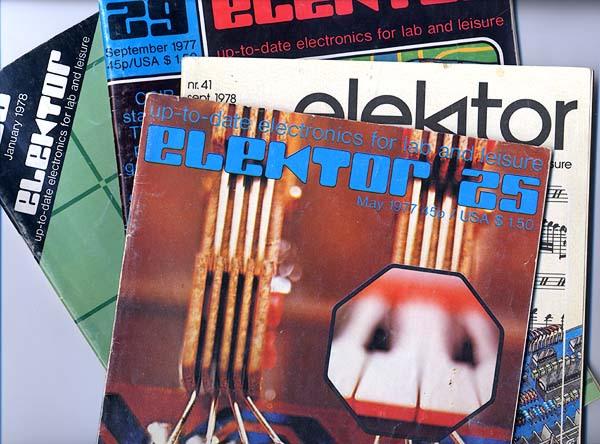
Everything started with the Elektor magazine
My
interest in synthesizers started in 1972, when I heard the songs
Popcorn by Hot
Butter and Son
of my Father by Giorgio Moroder. I was only a child and could not
buy records but I had managed to save money for a cassette recorder.
So it was a matter of taping songs from radio. One of the favourites
was Rod
Hunter's synth cover on the Shadows' Apache.
In 1974
Kraftwerk released their album Autobahn.
I had saved money and bought a stereo set and this became my first
synth record.
Fast
forward to 1976. A class mate at the upper secondary school loaned me
Switched-on Bach by Wendy Carlos, which I taped and loved. Promptly I
bought her LP with the music to the film A clockwork orange.
One
day in the autumn of 1977 I discovered the British magazine Elektor
at school. They had the issues where the Formant article series
started. There I found out, to my amazement, that you could actually
build your own synthesizer!
Since I had chosen the technology
program at the upper secondary school and was aiming for the
electrical engineering program in the third year, I really wanted to
get started with something electronic and this seemed like a dream
come true. However, electronics wasn't on the school program until a
year later. This didn't stop me and I learned the necessary
electronics from the very excellent magazine articles before I got it
taught in class.
A
design study I made for the planned synth. I have always been
interested in industrial design. My synth wasn't going to use the
standard Formant front panels.

Since
I had no equipment to etch circuit boards, I made the first boards by
grinding off the copper from blank copper clad fibreglass boards.
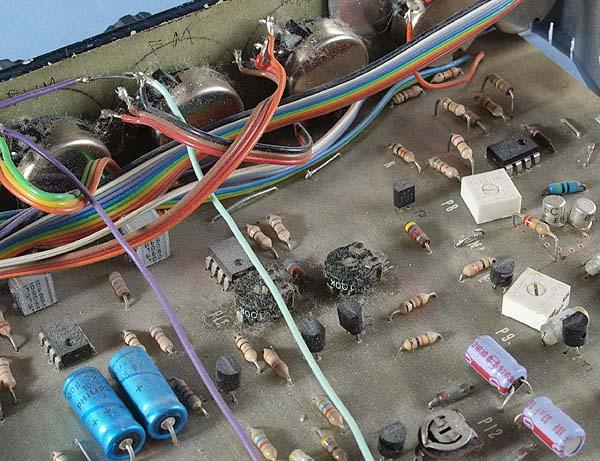
The
board looks like this on the component side. This is my version of
the Formant VCO. It actually worked. Eventually...

The
front panel even looked rather nice, with rub-on lettering.
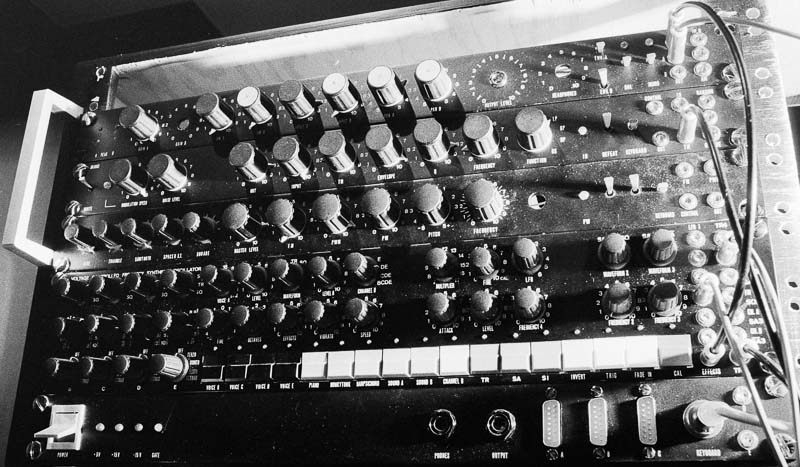
The
module case with the modules I had built. My choice of 19 inch rack
panels fore the modules turned out to be less than ideal.
After
the module case, I built a keyboard unit according to this drawing.
The keybed was from Wersi. Unfortunately, I have no decent photos of
this unit.
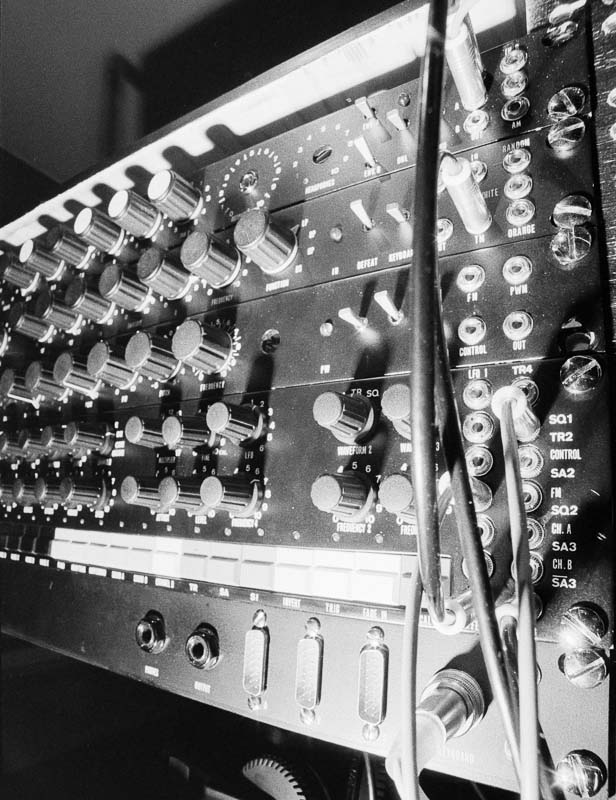
Another
picture of the module unit. I never finished more Formant-based
modules than these.
For the fourth and final year, I had to switch school. The new school was located at Södermalm, the part of Stockholm where most of the music instrument stores were. On the lunch breaks me and some classmates used to go to the stores and admire the synths. I specially remember the Yamaha CS80, which had some amazing features and was incredibly expensive.
I felt the maths had become too abstract in the final years of school. On an information day at the Royal Institute of Technology, they informed us that most of what you studied there was maths, maths and maths. I didn't apply. Instead I got a job as a service engineer at Siemens mainframe computers when school finished. It was quite easy to get a decent job in 1980, even as a certified upper secondary school engineer!
First thing on my first job, I was sent off to Munich, Germany for a two week introductory course. That was tough, since everything was in German and I was the only one on the course who was not from Germany. I had studied German in school but I had never been to Germany before.
Back home in Sweden, things went OK at
the job. In late 1980 we were seriously short of service personnel
and Siemens decided to loan us an engineer named Hans Kolber from
Munich for a couple of weeks. While I was driving him to a customer's
site, he asked me if I had any articles or plans for the 8085
microprocessor. He was interested in using it for a hobby project.
I
said ”No, I haven't looked at microprocessors. I'm more
interested in synths”.
He said ”Really?” (or
rather, something equivalent in German).
It turned out he was
into synths too! He even had brought a Synthi AKS, which he used in
the evenings when not working. A couple of evenings later I joined
him at the flat Siemens rented for loaned-in personnel and was
introduced to the Synthi.
A couple of months later I was in
Munich for another course and met up with Hans in the Siemens service
department where he worked. He suggested we should go to
Merianstrasse where he knew a person named Dieter, who made and sold
synthesizer kits. This sounded interesting to me, so I was happy to
agree.
Arrived at the flat, we were greeted by Dieter and first
admired an early Moog modular which he had in for service. Then we
had a demo of his kit system. It was a polyphonic modular synth. He
also had an interesting phaser unit, which I believe was his very
first kit. I left there with a couple of his kits, the printed
instructions for a few more and a number of D-mark notes missing in
the purse.

Circuit
boards to Doepfer's polyphonic modular system

The
polyphonic modular system could be built with four or eight voices.
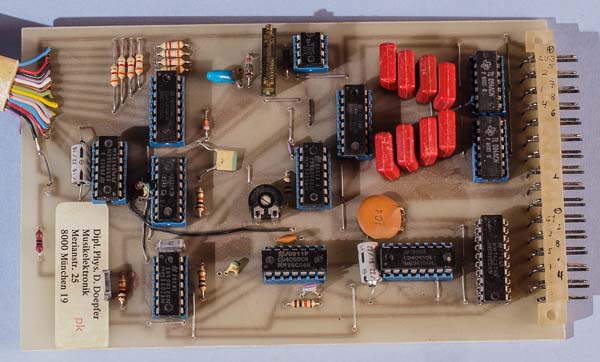
The
voice assignment in the polyphonic keyboard was a bit primitive, as
it didn't use a microprocessor.
Of
course, the new polyphonic modules did not fit into my keyboard unit.
To make more room, I designed a new bottom, which added height (the
black part).
The visit to Munich had also made me a member of the Informationskreis Musikelektronik. They had formed the year before and produced a photocopied publication with synth and electronic music articles six times a year. Back when there was no Internet, this was the one of very few ways to get hold of such information.
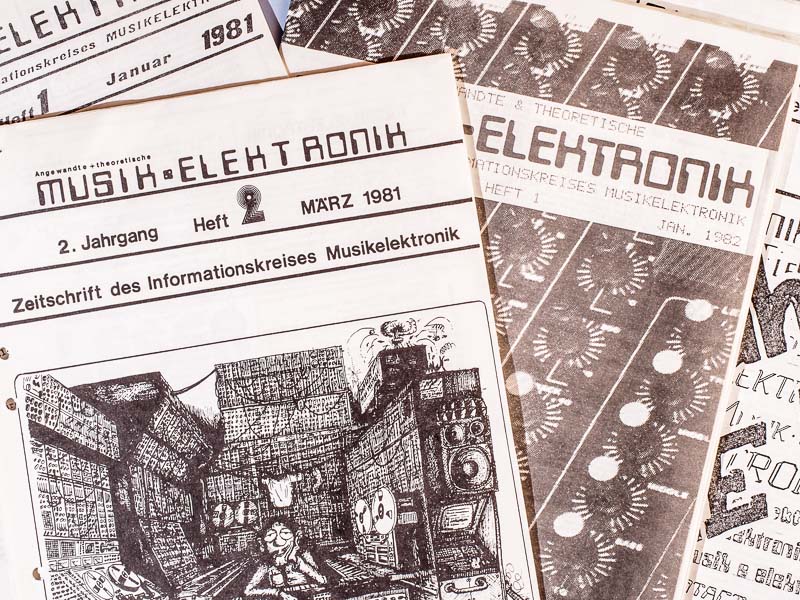
This
is what we had when there was no Internet.
I learned to photo-etch circuit boards at home and started work on a polyphonic synth based on the Doepfer boards and some of my own ideas. But such a system of course meant a lot of work and progress was slow. No doubt also because other interests took a sizeable part of my time.
It
turned out, the enlarged keyboard unit was still not large enough for
the polyphonic system. Among other things, I needed more panel space.
I had to design and build a new one.

This
is how the new keyboard unit looked when built.
New ideas evolved faster than I could build. This
became more and more frustrating. No matter how much I worked, the
synth didn't get closer to completion. Most of the work was in
replacing things I had already built but which I wasn't satisfied
with.
At around 1985, commercial synths started to come down in
price and I now had a decent income. Also, the commercial synths had
new features that my DIY system lacked. With the possibilities midi
promised, I finally gave up and bought an Ensoniq Mirage instead. An
Atari ST computer with Steinberg Pro24 sequencer gave me
possibilities my DIY synth could never have had. Soon, however, I
missed the analog synth sound. This problem was solved the year
after, with an Oberheim Matrix 6R, which I still have and love. My
polyphonic DIY system, using the Doepfer boards, never reached
playable condition.
Time went by and analog synths became retro cool. In 1998 I got the idea to refresh and repackage some of the modules from my Formant period into a traditional but more compact modular format. With the Doepfer Polymodule quad VCO board, I would have plenty of VCOs for a monophonic synth.

I
first tried a 2HE format for the new modules but this didn't turn out
quite well. Here is the Formant 24 dB/oct VCF with a new front panel.
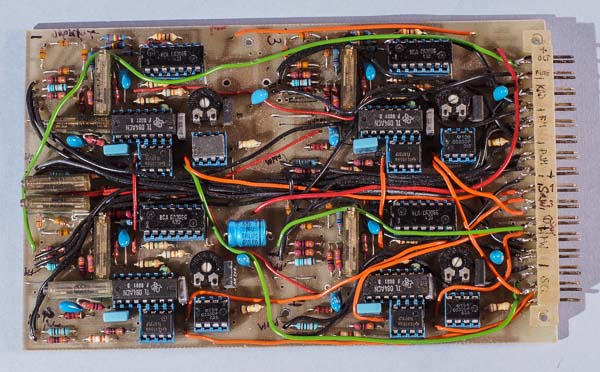
The
Doepfer Polymodule quad VCO could just as well be used for a four VCO
monophonic synth.
I now had access to Internet at work and somehow found out about the Synth DIY mailing list. Somewhere I was able to download the original schematics for most of the Moog modular modules and this inspired me to try and build some of them. I also came in contact with the Swedish SAS mailing list and through it the schematics for the ASM-1 synth. The Bergfotron was born. I decided on an own standard with 3HE modules. At that time there was no dominating standard on the market, like with Eurorack today.
The
first case for the Bergfotron was 19 inch rack sized and had room for
two rows of modules. Note the handles. They were carried over from
the old Formant case. This small case was soon outgrown.
After some time I was allowed some web space at work and then the Bergfotron website became reality.
In the middle of 2000 I had built more modules than there was room for in the case. A new, larger case was needed. Inspired by the ARP 2600, I decided to have built-in speakers. To simplify things, I choose to integrate PC-speakers from Creative, complete with subwoofer. This turned out to be a bad choice, since it made the synth extremely heavy. I made the decision to tear out the speakers. This, however, made the case a little unnecessary large.

The
new, much larger case. Note the speaker grille on the side.
Eventually I got internet access at home and a small server space with it. In September 8 2002 the Bergfotron site opened on my own server space and has been available there ever since.

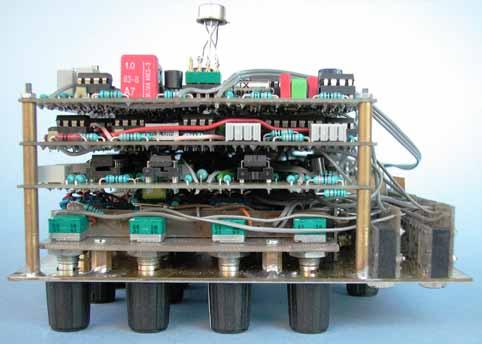
The
Complex VCO was one of the last modules I built for the original
Bergfotron. It was inspired by the Buchla Programmable complex
waveform generator model 259. As you can see from the side view, it
was indeed a complex module.
I was getting tired of all the
mechanical work involved in making modules. Especially that you had
to make considerable mechanics work before you even could test the
module and decide if it was worthwhile, sonically. Also, I wasn't
quite satisfied with the modular approach. It's tedious and time
consuming to create patches, which in my case meant that not much
music was created with the synth.
I wanted a system where the
boards could be thoroughly tested before committing to the mechanical
work. I also wanted general purpose circuit boards that could be used
in a classic modular but also in any other type of synth. Even a
polyphonic one.
After a lot of thinking, I had a concept that
fulfilled my wishes in the spring of 2008. The AMORE
standard was born.
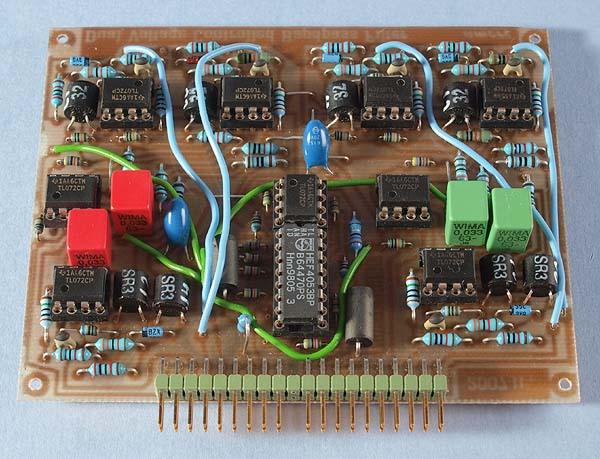
The
first AMORE board, the dual voltage controlled bandpass filter.
In the last ten years, my activity in the synth hobby sector have varied greatly. There has been many more AMORE boards released but there has also been long periods of no activity. What will come next remains to be seen. The move to synth.net marks the forty year anniversary for my synth DIY hobby.